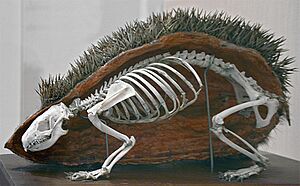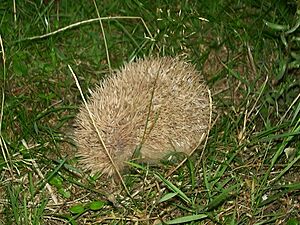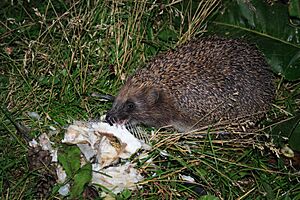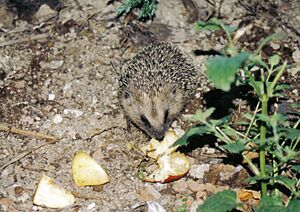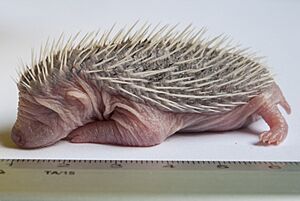European hedgehog facts for kids
Quick facts for kids European hedgehog |
|
|---|---|
 |
|
| Conservation status | |
| Scientific classification | |
| Genus: |
Erinaceus
|
| Species: |
europaeus
|
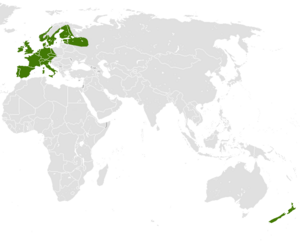 |
|
| Range including introductions | |
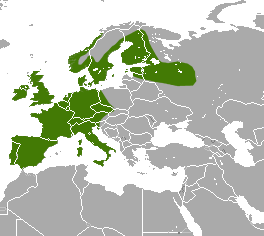 |
|
| Native range of European hedgehog | |
The European hedgehog (Erinaceus europaeus) is a cute, spiky mammal. It is also called the West European hedgehog or common hedgehog. These hedgehogs live naturally in Europe, from Spain and Italy all the way north to Scandinavia. They also live west into the British Isles.
Hedgehogs are common and live in many different places. People love seeing them in their gardens. They look adorable and help by eating garden pests. While many hedgehog groups are doing well, their numbers are dropping fast in Great Britain. Here, they are now on a "Red List." This means they might disappear from those areas. European hedgehogs were also brought to New Zealand long ago.
Contents
What Does a European Hedgehog Look Like?
European hedgehogs have a normal body shape. Most of their body is covered in up to 6,000 brown and white spines. When they are young, their body is about 16 centimeters (6 inches) long. Adult hedgehogs can grow to 26 centimeters (10 inches) or more.
They have a very short tail, only about 2 to 3 centimeters (1 inch) long. Young hedgehogs weigh around 120 grams (4 ounces). Adults can weigh over 1,100 grams (2.4 pounds). Some have even weighed 2,000 grams (4.4 pounds). But most wild adults are less than 1,600 grams (3.5 pounds).
Hedgehogs weigh more in autumn than in summer. This is because they get ready for winter. Males are usually a bit bigger than females. But their weight changes a lot with the seasons.
The European hedgehog looks different from most other animals in its home areas. There is another type, the northern white-breasted hedgehog. It looks very similar but has a white spot on its chest. The European hedgehog is likely the biggest and heaviest hedgehog species.
Blonde Hedgehogs
Sometimes, you might see "blonde" hedgehogs. These hedgehogs have black eyes and creamy spines. This happens because of a rare genetic trait. They are not true albinos.
Blonde hedgehogs are very rare. But on the island of Alderney and North Ronaldsay, about 25% of the hedgehogs are blonde!
How Do European Hedgehogs Live?
European hedgehogs are mostly active at night. They walk slowly, often stopping to sniff the air. Unlike hedgehogs from warmer places, European hedgehogs may sleep through the winter. This is called hibernation. Most wake up at least once to move their nests.
What Do Hedgehogs Eat?
European hedgehogs are insectivores. This means they mainly eat insects. Their favorite foods include:
- Earthworms
- Snails and slugs
- Beetles
- Ants
- Bees and wasps
- Earwigs
- Crickets and grasshoppers
- Butterflies and moths
- Caterpillars and other insect larvae
They might also eat eggs from birds that nest on the ground. Sometimes, they will eat dead animals. Hedgehogs can also hunt lizards, snakes, frogs, and small rodents. They do not eat much plant material.
Reproduction and Young Hedgehogs
Hedgehogs start to breed after they wake up from hibernation. Most babies are born between May and July. But some can be born as late as September. A mother hedgehog is pregnant for 31 to 35 days.
The mother raises her babies alone. She usually has four to six babies, but can have two to ten. In colder northern areas, litters might be bigger. Newborn hedgehogs are born blind and have small spines. After about 36 hours, a second layer of spines starts to grow. By 11 days old, they can roll into a ball. They stop drinking their mother's milk at about six weeks old.
How Long Do Hedgehogs Live?
European hedgehogs can live for more than ten years. But most only live for about three years. The most common reason they die is starvation, especially during hibernation.
If a hedgehog feels scared, it will roll into a tight ball. This protects it with its sharp spines. Many animals cannot get past the spines. But some animals do hunt hedgehogs.
Many times, these animals might just be eating hedgehogs that have already died, like from roadkill. However, hedgehogs are often not found in places where there are many badgers.
Eurasian eagle-owls and golden eagles are the main birds that hunt hedgehogs. These birds might even prefer to eat hedgehogs. An eagle-owl often grabs a hedgehog by its face. Then, it skins the hedgehog's spiky back before eating it. This is why hedgehog backs are sometimes found near eagle-owl nests.
Where Do European Hedgehogs Live?
The European hedgehog lives naturally across Europe. This includes the British Isles, Spain, and Portugal, all the way east to central Europe and northwest Russia. They also live on some Mediterranean islands like Corsica and Sicily. They have been brought to New Zealand and probably to Ireland.
People brought hedgehogs from England and Scotland to New Zealand in the late 1800s. They hoped the hedgehogs would eat farm pests or be pets. Not many survived the long boat trip. The ones that did had lost all their fleas! Hedgehogs first settled in New Zealand's South Island. Railway guards helped them spread by dropping them off at country stations.
By the 1920s, there were so many hedgehogs in New Zealand that hunters blamed them for fewer game birds. For a while, people even paid money for each hedgehog snout. By the 1950s, hedgehogs lived almost everywhere in New Zealand.
New Zealand hedgehogs do not get as heavy as those in colder parts of Europe. This is because New Zealand has milder winters. Hedgehogs there only hibernate for about three months. In northern New Zealand, many do not hibernate at all.
Most New Zealanders like having hedgehogs in their gardens because they eat slugs and snails. But nature experts are not happy. Hedgehogs compete with native birds for food. They also eat rare insects, lizards, and ground-nesting birds. So, there are now programs to control hedgehog numbers in some areas.
European hedgehogs live in many different places. This includes natural areas and places changed by humans. They can be found in:
- Woodlands
- Grasslands (like meadows and pastures)
- Farm fields
- Orchards and vineyards
- Gardens and parks in towns and cities
They prefer lower lands and hills. But they can also live in mountains, sometimes as high as 1,500 to 2,000 meters (about 5,000 to 6,500 feet). They like the edges of forests, especially where grass and bushes meet.
Hedgehogs are most common in gardens, parks, and other green spaces near people. They are usually rare in pine forests, marshes, and moorland. This is probably because these places do not have good spots or materials for building their winter nests.
Protecting European Hedgehogs
Overall, the European hedgehog is widespread. You can find many of them where people let them live in gardens. The IUCN (a group that checks animal populations) says the species is "Least Concern." This means they are not currently in danger globally. Their population is stable.
However, many hedgehogs are killed by cars on roads. In places like Sardinia, dogs might hunt them. In 2007, the European hedgehog was added to a list of animals in Britain that need more protection.
In Denmark and Poland, it is against the law to catch or hurt hedgehogs. But it is okay to help sick hedgehogs get better. Hedgehogs are protected in all European countries that signed the Berne Convention. This agreement helps protect European wildlife.
Hedgehog Status in Great Britain
Hedgehog Numbers in Great Britain
It was once thought there were 36.5 million hedgehogs in Great Britain. But this number was likely too high. A more recent guess is about 1.55 million hedgehogs in Great Britain. This includes 1.1 million in England, 310,000 in Scotland, and 140,000 in Wales. However, this number is still hard to know for sure. It is now believed there are fewer than a million hedgehogs in Great Britain.
In the UK, badgers are the main hunters of hedgehogs. Badgers also eat some of the same foods as hedgehogs. The number of badgers has grown a lot recently. This might be a big reason why hedgehog numbers are falling in England.
Why Hedgehog Numbers are Declining
In 2007, the hedgehog was listed as a "priority" species in Britain. This was because surveys showed their numbers were dropping. For example, a survey called Mammals on Roads found that hedgehog road deaths fell by about 7% each year from 2001 to 2004. This suggests fewer hedgehogs were around. Old records from 1960 to 1980 also showed a steady decline.
A survey in 2005 and 2006 also showed a drop. Almost half of 20,000 people said they saw fewer hedgehogs than five years before. Experts looked at all the survey data. They found that at least 25% of British hedgehogs were lost in just ten years.
Newer studies suggest that hedgehog numbers in the countryside have dropped by at least half since 2000. In cities, their numbers are down by about a third.
Hedgehogs as Pests
In some places where hedgehogs were brought by people, they have become a problem. For example, in the Western Isles of Scotland, introduced hedgehogs eat the eggs of ground-nesting birds. These birds include common snipe and northern lapwing.
Hedgehogs are also seen as a pest in New Zealand. They eat many native animals there. This includes insects, snails, lizards, and birds that nest on the ground. Since they are not native, they do not have natural enemies in New Zealand.
People tried to remove hedgehogs from bird nesting areas on the Scottish islands of North Uist and Benbecula. This caused a lot of anger around the world. At first, they killed the hedgehogs. But animal welfare groups tried to save them. By 2008, the plan changed. Now, they trap the hedgehogs and move them to the mainland instead of killing them.
See also
- Hedgehog Street
- Hedgehogs in New Zealand



